Today we are exploring the Popular Backyard birds of Montana and it’s a hefty subject. Montana provides a range of habitats through the sheer diversity of climate and foliage in the state. You’ve got plains in the east, cold in the south, and yet the northwest is a veritable rainforest. As a result of this unique combination Montana is home to 433 avian species!
A birdwatcher could retire happily here.
While we could inundate you with statistics about how likely you are to see each bird, where’s the fun in that? These are ALL birds that can potentially be lured to your backyard so that you can see them in all of their glory. We’ll provide you with their descriptions and what they love to eat (the seed recommendations are courtesy of Birds and Beaseleys) and it’s up to you, dear Birder, to wait, watch, and see!
3 Categories – 433 Birds
With so many avian species we can’t possibly chronicle them all so we’ve taken examples of 5 backyard birds and we’ll be dividing them up by seasons. We will list them as follows:
- Year-round Resident birds
- Birds of Spring, Summer, and Early Fall
- Fall and Winter Birds
We’ll give you the information that you need to identify them and lure them but no promises! Their personalities vary, as you well know, and while some are bold other birds are as shy as they are graceful. So set up your feeder but be patient. The wait is always worth it.
Montana’s Year-round Resident birds
These birds are dedicated to their home state and they stick around from January through December. This means that at any time of the year you might be lucky enough to spot one flittering around in your backyard or gracing your garden. The year-round residents we will focus on today are the following birds:
- Cassin’s Finch
- Pine Siskin
- Downy Woodpecker
- Stellar’s Jay
- Red-Winged Blackbird
Cassin’s Finch – Haemorhous cassinii

Coloration and Markings: Male Cassins exhibit a pink hue over most of their bodies capped off with a vibrant red on top. Females and younger Cassins, however, are brown and white with pronounced streaks on their chests. Both males and females have streaked and notched undertails. Facially, they have heavy, straightsided bills as well as a thin white eye ring
Size: This tiny songbird is around the same size as a House Finch but with a bit more weight. A little larger than a Pine Siskin, the Cassin has a length of 6.3 inches with a 9.8 -10.6 inch wingspan.
Habitat: Typically found at an elevation of 10,000 feet, these birds typically live in the evergreen forests of Montana’s mountains. They are sometimes found at lower elevations during the winter.
Diet: Feeding primarily on seeds and tree buds in the wild, these birds may be tempted to visit your feeder for Black Oil Sunflower, Nyjer Thistle, Suet,and Peanut Butter & Cornmeal.
Pine Siskin – Spinus pinus

Coloration and Markings: Pine Siskins have a streaked appearance, with brown and white streaks all over their bodies and slashes of yellow on their wings as a beautiful contrast. They also have short, forked tails. Facially, they have pointy, sharp bills, which are slimmer than most finches.
Size: Just a little bit smaller the American Goldfinch, with a length of 4.3 – 5.5 inches and a wingspan of 7.1 to 8.7 inches.
Habitat: Pine Siskins love their evergreen forests but they are bold foragers, looking for food in fields, gardens, and backyards.
Diet: Fond of thistle feeders, you can lure in Pine Siskin’s with some of their favorites, which are the same as Cassin’s finch. A bird-buffet of Black Oil Sunflower, Nyjer Thistle, Suet,and Peanut Butter & Cornmeal will not go unnoticed if a Pine Siskin is near.
Downy Woodpecker – Picoides pubescens
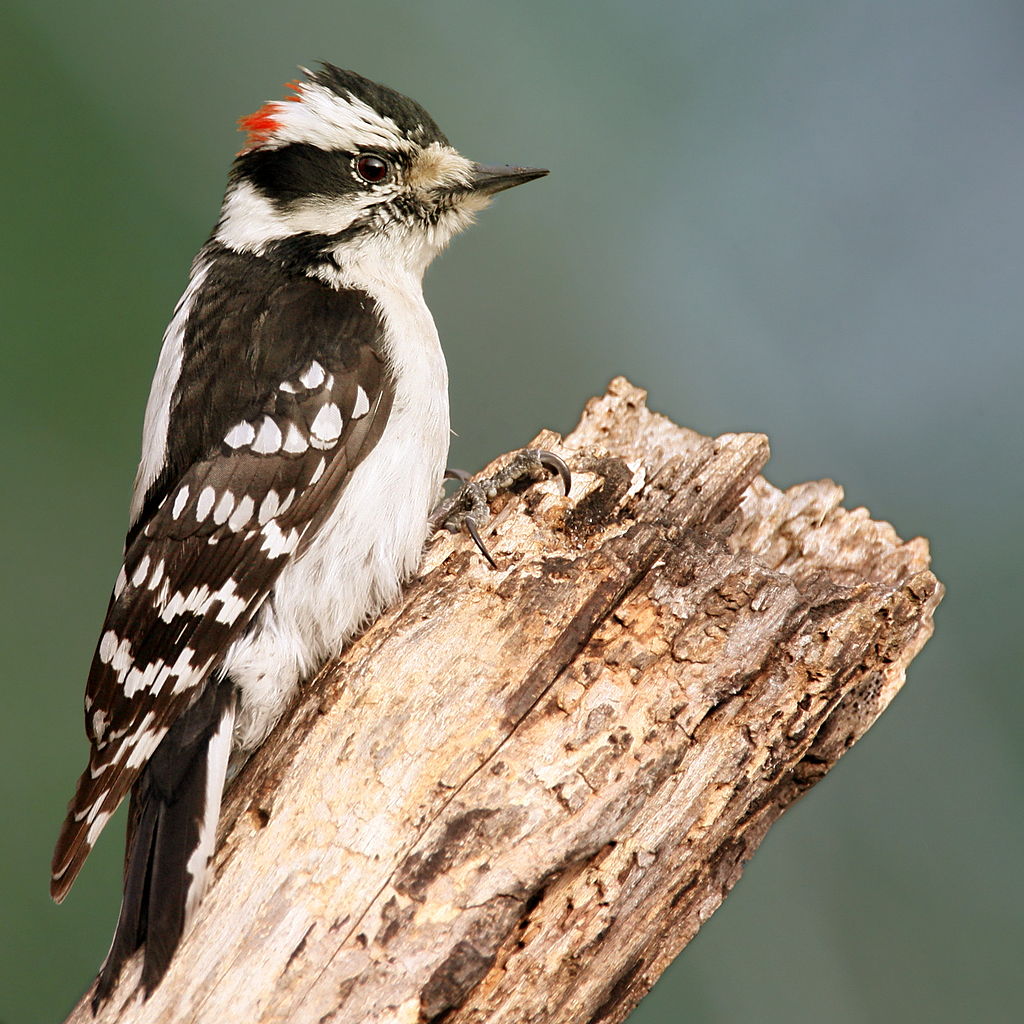
Coloration and Markings: Black and white with distinct stripes on the head, the male Downy Woodpecker also displays a red tuft of feathers at the top back of the head, A large white stripe looks painted across the bird’s back while the wings have more of a ‘checkered’ look to them. Facially, the bird has a very blocky head with a short, sharp beak and ‘black mask’ stripes extend from the bridge of the beak all the across the eyes.
Size: Slightly smaller than the Hairy Woodpecker, the Downy measures in at 5.5 – 6.7 inches with a wingspan of 9.8 to 11.8 inches.
Habitat: Frequenting open woods, brush, and sometimes even foraging in the weeds, the Downy Woodpecker is also quite at home in gardens, orchards, and backyards.
Diet: Downy Woodpeckers will be tempted to visit your feeder if you include Black Oil Sunflower, Peanuts, Suet, and Peanut Butter & Cornmeal.
Steller’s Jay – Cyanocitta stelleri
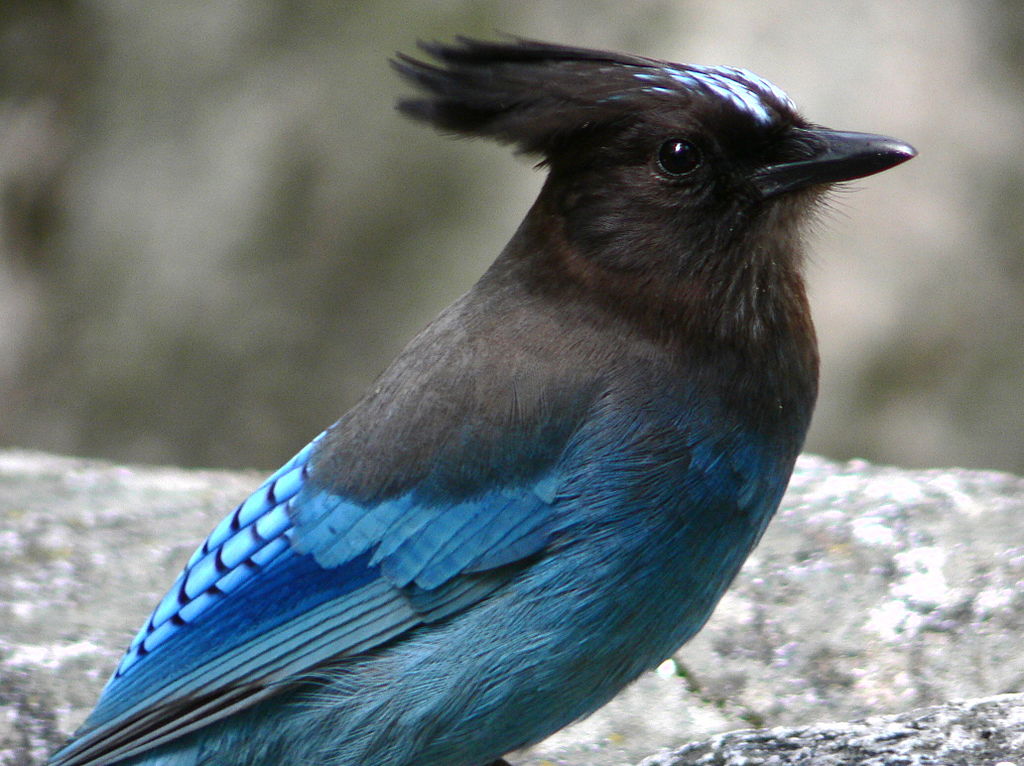
Coloration and Markings: The stunning Steller’s Jay has an evony-colored head with the black coloration extending further down, almost as if wearing a hood. The remainder of the body is a striking blue color, all the more noticeable due to the fact that the belly is not white like many other Jays. Facially, the Steller’s Jay has a striking crest on the top of its head which is either back or standing straight up and tiny white lines look to have been penciled in over each eye. They also have long, slightly curved beaks.
Size: This is a large bird, with a length of 11.8 – 13.4 inches and a wingspan of 17.3 inches. It is about the same size as the Western Scrub Jay.
Habitat: Steller’s Jaysfrequent evergreen forests and are fond of campgrounds, parks, and backyards as well.
Diet: You can tempt these tall Jays with Peanuts, Suet, Peanut Butter & Cornmeal, Black Oil Sunflower, and White Proso Millet.
Red-Winged Blackbird – Agelaius phoeniceus

Coloration and Markings: Completely black, with the exception of a marking on the top wing that rather resembles an orange shark fin when the wings are folded (as if the shark is swimming in a white line). Once the wings are extended, the markings become more prominent. Facially, this bird has a thin, sharp beak that resembles an ebony ice-cream cone. Females of the species are more brownish in color and there is some whitening around the eyes.
Size: Almost as large as a Grackle, the Red-Winged Blackbird measures 6.7 – 9.1 inches in length and they have a wingspan 12.2 to 15.8 inches.
Habitat: Red-winged Blackbirds are drawn to water although you can sometimes find them in fields or pastures.
Diet: Black Oil Sunflowers seeds are a favorite of the Red-Winged blackbird. Sprinkle some around the base of the feeder as well, as this bird prefers to feed on the ground.
Montana’s Birds of Spring, Summer, and Early Fall
These birds love Montana but they hate the winters (they’re not for everyone, as you know). Until it’s starts to get frosty, however, they play and fall in love in various locales throughout Montana’s diverse climates. Only 4 backyard birds fit this category and while we realize there are some others you might see, those are likely year-rounders. Montana’s birds of Spring, Summer, and early Fall to look for are:
- Lazuli Bunting
- Chipping Sparrow
- Western Tanager
- Brown-headed Cowbird
Lazuli Bunting – Passerina amoena

Coloration and Markings: The Lazuli Bunting is a brilliant blue with black accents, contrasted by a pumpkin and white belly. The males have a white shoulder patch and tend to be a more brilliant blue while the females are grayish brown on the upper body with splashes of blue on the wings and tail. The females have a more cinnamon colored breast or sometimes tan. Young buntings have the pumpkin breast but they are tan and blue on both their heads and their backs. Facially, they have small and sharp conical bills
Size: Finch sized, the Lazuli Bunting measures in at 5.1 – 5.9 inches with a wingspan of 8.7 inches.
Habitat: Lazuli Buntings are fond of brush, hedges, and gardens.
Diet: White Proso millet is a favorite that you can use to lure one of these beauties to your feeder.
Chipping Sparrow – Spizella passerina

Coloration and Markings: The Chipping Sparrow has a grey belly and head with wings which are brown with black streaks. Facially, this bird has a crown on the top it’s head that’s the color of rust and a black stripe crossing the eye. The beak is short and triangular and you’ll notice that it’s shorter than you usually see on other sparrows. These birds have long tails.
Size: With a length of 4.7 – 5.9 inches and a wingspan of 8.3 inches, these birds are just slightly smaller than your average sparrow.
Habitat: Woodlands, roadsides, and backyards, these birds are not shy about visiting gardens or feeders.
Diet: White Proso millet can lure this bird to your feeder and keep them coming back for more.
Western Tanager – Piranga ludoviciana
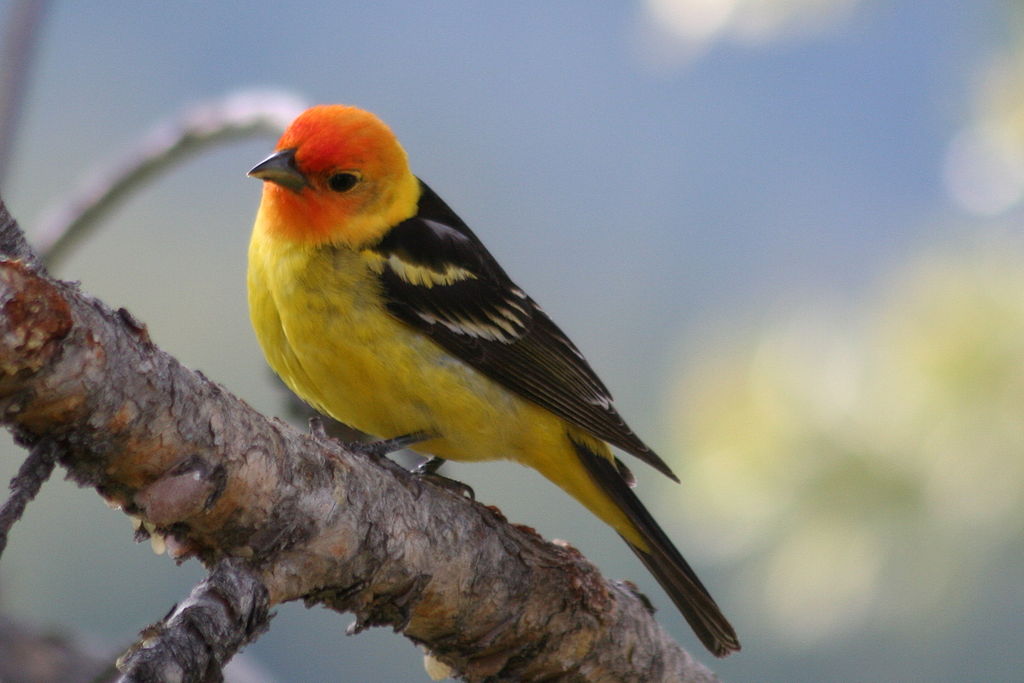
Coloration and Markings: The Western Tanager is is bursting with color, with yellow bodies in stark contrast with black wings. The wings have two wingbars, with a yellow one on the upper wing and a white wingbar on the lower part of the wing. Facially, their heads are rounded, with short, sharp bills, and the red coloration on their heads mixes with the yellow like a tiny fire. Females have the red as well but it is focused towards the front of the face and their body coloration tends more to yellow green. Think of the males as ripe bananas by comparison to get a mental image of the coloration. Juveniles display very little to no red until maturation.
Size: At 6.3 – 7.5 inches these birds are between robin and sparrow sized. They have a wingspan of 11.5 inches.
Habitat: Western Tanagers love forests and are fond of conifers. You’ll find them sometimes around juniper pines, spruce firs, and pine oak forests. If you have trees in your backyard then this may tempt them to visit your feeder or pick about your garden.
Diet: Black Oil Sunflower and Suet are two favorites of the Western Tanager and leaving them out might earn you a repeat guest at your humble feeder.
Brown-headed Cowbird – Molothrus ater

Coloration and Markings: Male Cowbirds look completely shiny blue-black from a distance, however, up close you will notice that they have distinct, soft-brown heads. The females, by contrast, are completely brown with the exception of delicate black streaking (as if ‘penciled in’) and lighter underbellies and heads. Facially, aside from the brown these birds have conical, medium sized bills.
Size: These birds measure in at 7.5 – 8.7 inches and they have an ample wingspan of 14.2 inches. This makes them just slightly smaller than the Red-Winged Blackbird.
Habitat: Fields, meadows, the forests edge… These birds like to wander and if you see one perched in a tree in your backyard, don’t be surprised. These birds are fond of backyards, gardens, and feeders and they aren’t shy about it.
Diet: Black Oil Sunflower and Peanut Butter & Cornmeal can tempt these brown-tops to visit your feeders.
Montana’s Fall and Winter Birds
Some birds like it cold and that’s alright. Some people feel the same way. A little cold can be invigorating and for the birdwatcher who doesn’t mind the chill the following birds may present themselves:
- Gray-crowned Rosy-finch
- Black-headed Grosbeak
- White-throated Sparrow
- American Tree Sparrow
- Common Redpoll
Gray-crowned Rosy-finch – Leucosticte tephrocotis

Coloration and Markings: The Gray-crowned Rosy-finch has a short tail and a rich, brown body. The wings are gray, suffused with pink streaks. Facially, this finch has a grey head with a black crown, capped off by a short yellow bill. The females appear much the same but with less pink.
Size: This bird measures 5.5 – 8.3 inches in length with a 13 inch wingspan
Habitat: This is a hardy mountain bird and it forages where it likes. This means you can see it often at lower elevations and it doesn’t mind foraging in high winds or the snow. If you’ve got a feeder this bird won’t be shy about visiting once it’s become aware of it.
Diet: You can tempt these little guys to visit with Black Oil Sunflower seeds.
Black-headed Grosbeak – Pheucticus melanocephalus

Coloration and Markings: Males are orange and cinnamon short tails and black wings splotched with white. Facially, they have black heads with strong, grayish bills, and you can see yellow under their wings when they are in flight. The females and immature males only have the orange on the breast and belly areas, with brown patterns on their heads and wings. It rather looks like they are wearing little brown coats. Once you’ve seen the orange-cinnamon coloration you’ll recognize these birds at a glance.
Size: Black-headed Grosbeaks measure in about the same size as a Robin, approximately 7.1 – 7.5 inches with a 12.6 inch wingspan.
Habitat: Mountain forests, thickets, and even streams in the more arid climates attract this bird. They are no strangers to backyard feeders and gardens, either.
Diet: You can tempt them to your feeder by adding Black Oil Sunflower seeds, which their powerful bills can shell with ease.
White-throated Sparrow – Zonotrichia albicollis
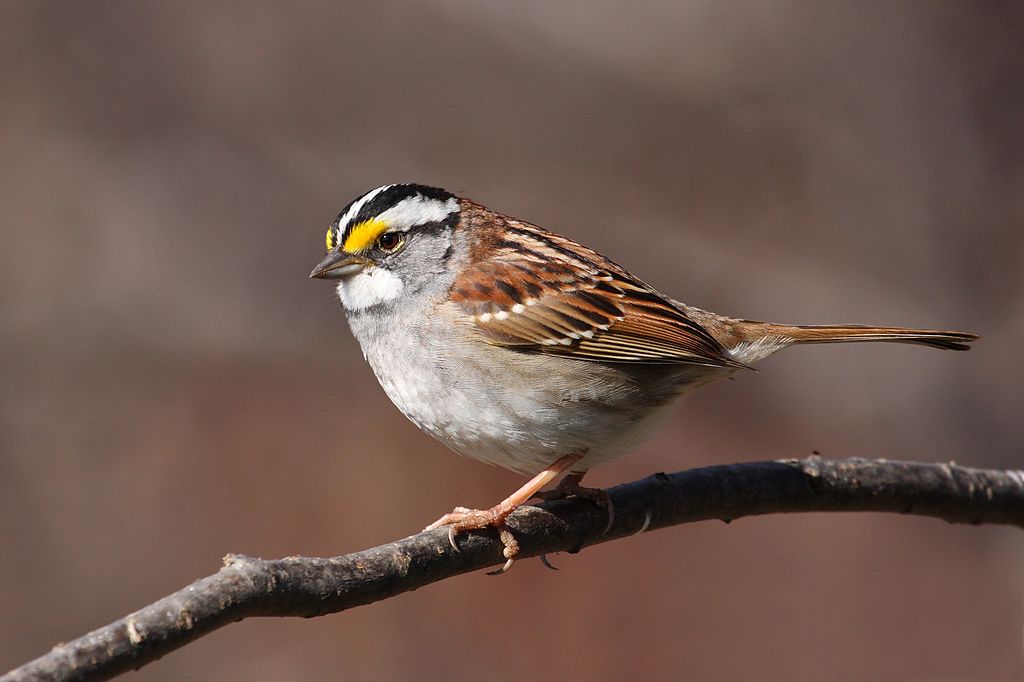
Coloration and Markings: The White-throated Sparrow has a gray underbelly, brown wings, and of course, a white throat. Facially, the grey from the underbelly extends around the throat and to the bill, while the rest of the face is black and white striped with just a touch of yellow above and between the eye and bill. Some of these sparrows, however, have brown faces instead with the same striping pattern. These sparrows have long tails.
Size: White-throated Sparrows are 6.1 – 7.1 inches from head to tail and have wingspans of approximately 7.1 to 9.1 inches in length.
Habitat: These birds love the woods and they are also attracts to ponds and bogs, though in the winter they prefer thickets. They don’t shy away from backyards although they do prefer if you have a few trees.
Diet: You can tempt their little tummies by addingWhite Proso millet to your feeder.
American Tree Sparrow – Spizella arborea

Coloration and Markings: The American Tree Sparrow may be recognized by a grey to brown breast, with a streaked brown back and white shoulder highlights, often with a ‘smudge’ mark on the breast (but not always). They have long tails and facially this bird has a rust-colored cap as well as a single downward-curved rusty stripe across and beyond the eye to the back of the head. The rest of the face is gray, excepting the stocky yellow and black bill of this bird.
Size: These are little guys, measuring in around 5.5 inches in length with wingspans almost twice that size at approximately 9.4 inches.
Habitat: American Tree Sparrows like the cold and in winter you’ll spot them sometimes in fields or near water. They love it when there’s a feeder in someone’s backyard so be sure to leave a little welcome out for them.
Diet: White Proso millet will get their attention and they’ll be sure to remember where YOU live.
Common Redpoll – Acanthis flammea
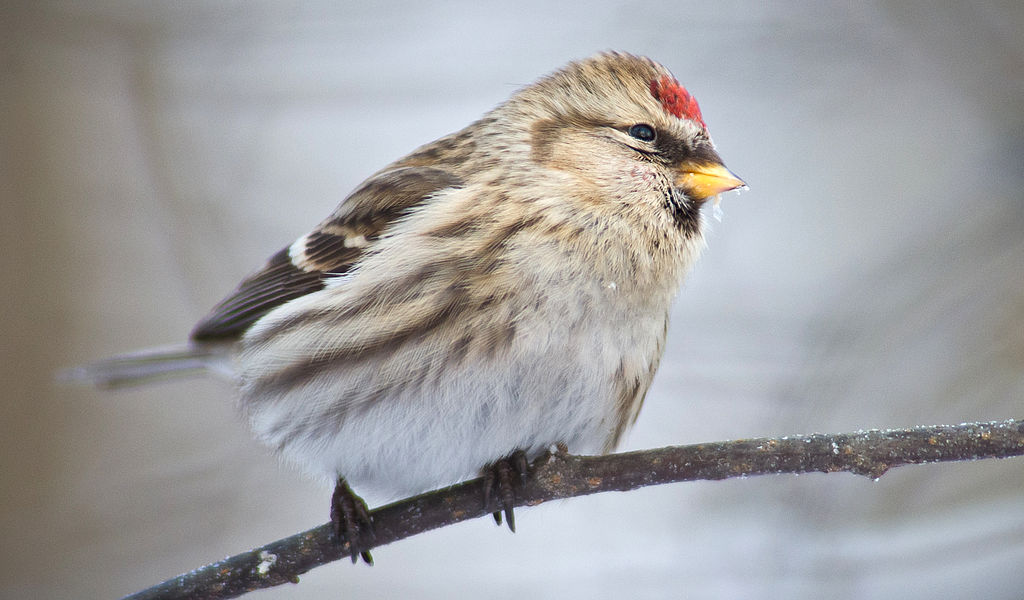
Coloration and Markings: Brown and white with heavy streaking, these birds have short, notched tails and two white wingbars. They also have a striking pink or red coloration splotched on the breast (for the males). Facially, the bird has a red cap, an upward-curved black stripe on the eye which terminates at an equal length to the cap termination, and a tiny, slightly curved yellow beak.
Size: These are small birds, measuring 4.7 – 5.5 inches in length, with wingspans of 7.5 to 8.7 inches.
Habitat: These little wonders love conifer forests as well as weedy fields, which they happily forage (sometimes in flocks of hundreds!). Though they are small, they are not about visiting your garden or feeder and will happily feast for your enjoyment if you leave them some trifles.
Diet: Black Oil Sunflower will tempt them and if they can’t open them then they will eat the leavings of larger birds when it comes to this delicacy. They are exceptionally keen on Nyjer Thistle, though, so that’s your best bet if you’d like to lure them over.
Other Backyard Birds of Montana That Might Pay You a Visit
Aside from our seasonal stars, there are a number of other birds who are just waiting to pay your backyard a visit. These are all year-round birds and you never know when one might pop in, so be sure there are some snack waiting and that you check the yard on occasion. You don’t want to miss them!
- House Finch
- Black-capped Chickadee
- Red-breasted Nuthatch
- Hairy Woodpecker
- Blue Jay
House Finch – Haemorhous mexicanus
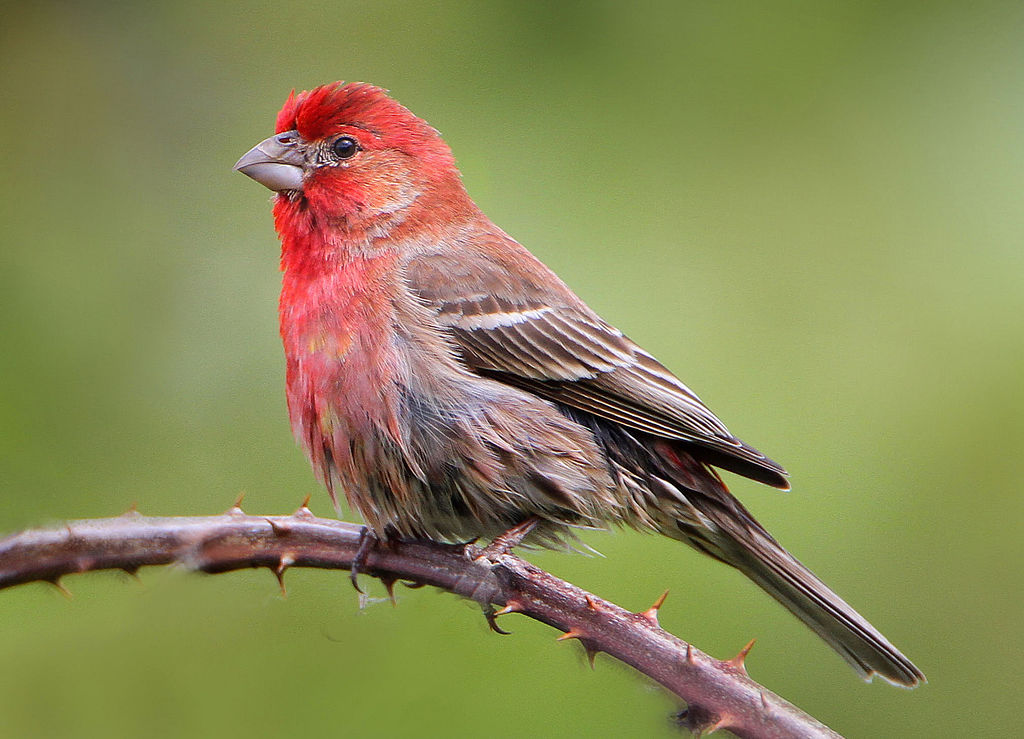
Coloration and Markings: Adult males of this species are beautiful, with the upper breast and head a stunning crimson with a gray belly and a brown-streaked back. They have short wings and there is a notch on its short tail but it is minimal. Facially, there are gray trails through the red on the portion of the face under and across the eye to the back. Sometimes this is like a stripe, other times just noticeable splotches of gray. Female Finishes do not share the same markings, being gray and brown and of the same shape but the red is absent.
Size: At 5.1 – 5.5 inches they are about the same size as a sparrow, sometimes just under. This is a tiny bird. They have a wingspan of approximately 7.9 to 9.8 inches.
Habitat: These birds will quickly locate and frequent feeders whenever possible and they aren’t above hanging out in a nearby tree to wait until the morning refill. These birds like to forage in weeds and woods, taking quick, small flights when something potentially tasty gets their attention.
Diet: Beaseley’s advises thatthe House Finch is partial to Suet, Peanut Butter & Cornmeal, Black Oil Sunflower, and Nyjel Thistle.
Black-capped Chickadee – Poecile atricapillus
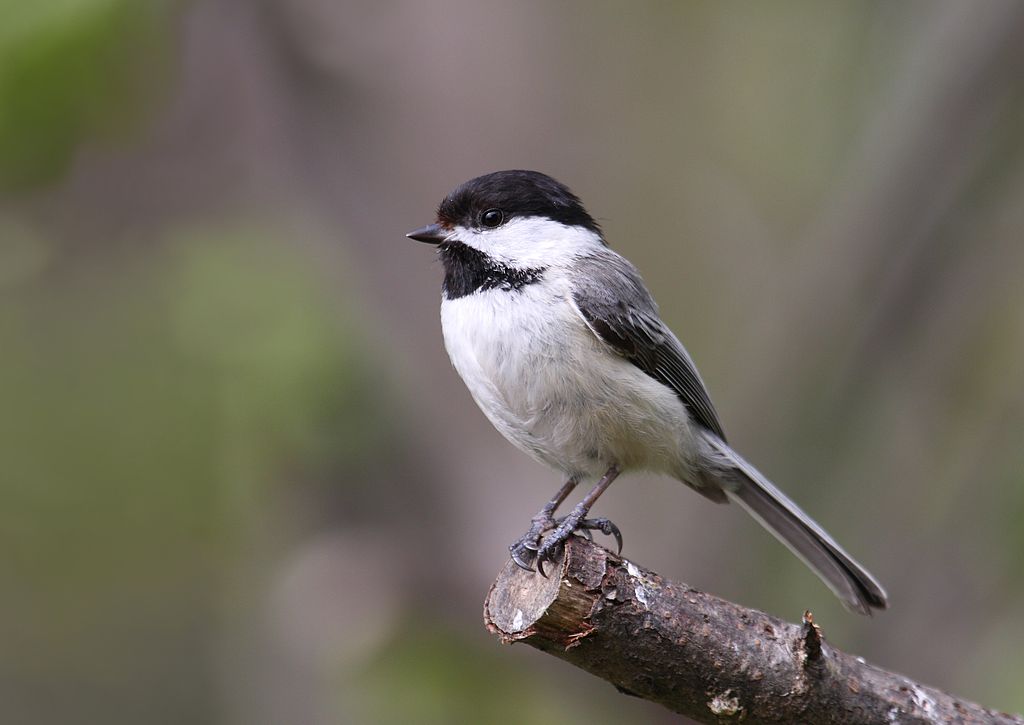
Coloration and Markings: This tiny, almost grayscale bird has a white breast and belly and gray wings accented with white. Facially, this bird has distinctive black cap starting at just under eye level across a white face. The cap extends around to come under the chin, giving the face an appearance as if abroad white stripe were painted across black. The bill is short and thin.
Size: The Black-capped Chickadee is a diminutive bird, measuring in at 4.7 – 5.9 inches with a wingspan of 6.3 to 8.3 inches.
Habitat: Very fond of Alder and Birch trees, these birds may be found in a diverse number of locations. Woods, marshes, weeds, parks, and residential neighborhoods –this is a bold bird and they love to frequent feeders once they’ve noticed them.
Diet: You can lure them the Black-capped Chickadee into making your backyard their hangout spot by adding Suet, Peanuts, Peanut Butter & Cornmeal, and Black Oil Sunflower as part of your feeder’s feast.
Red-breasted Nuthatch – Sitta canadensis
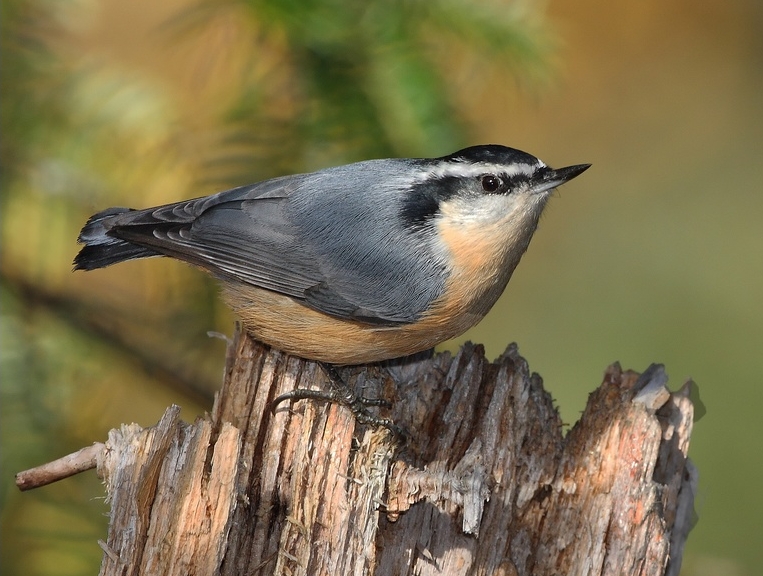
Coloration and Markings: Despite the name, these birds have more of a cinnamon colored breast and blue wings with white accents towards the tip of its short tail. Facially, this bird has a long, short black bill and a blue or black cap with a white stripe over the eye and a blue stripe over the eye. Females have lighter cinnamon coloration on the breast.
Size: These are little birds, averaging about 4.3 inches in length with a wingspan of 7.1 to 7.9 inches.
Habitat: Fond of coniferous forests and mountains as well, they like firs, pines, red cedar, and poplars. They are also no strangers to oak and hickory. They don’t mind gardens or feeders but it doesn’t hurt if you have trees in the yard.
Diet: These little guys love Peanut Butter & Cornmeal, Black Oil Sunflower, Suet, and Peanuts.
Hairy Woodpecker – Leuconotopicus villosus
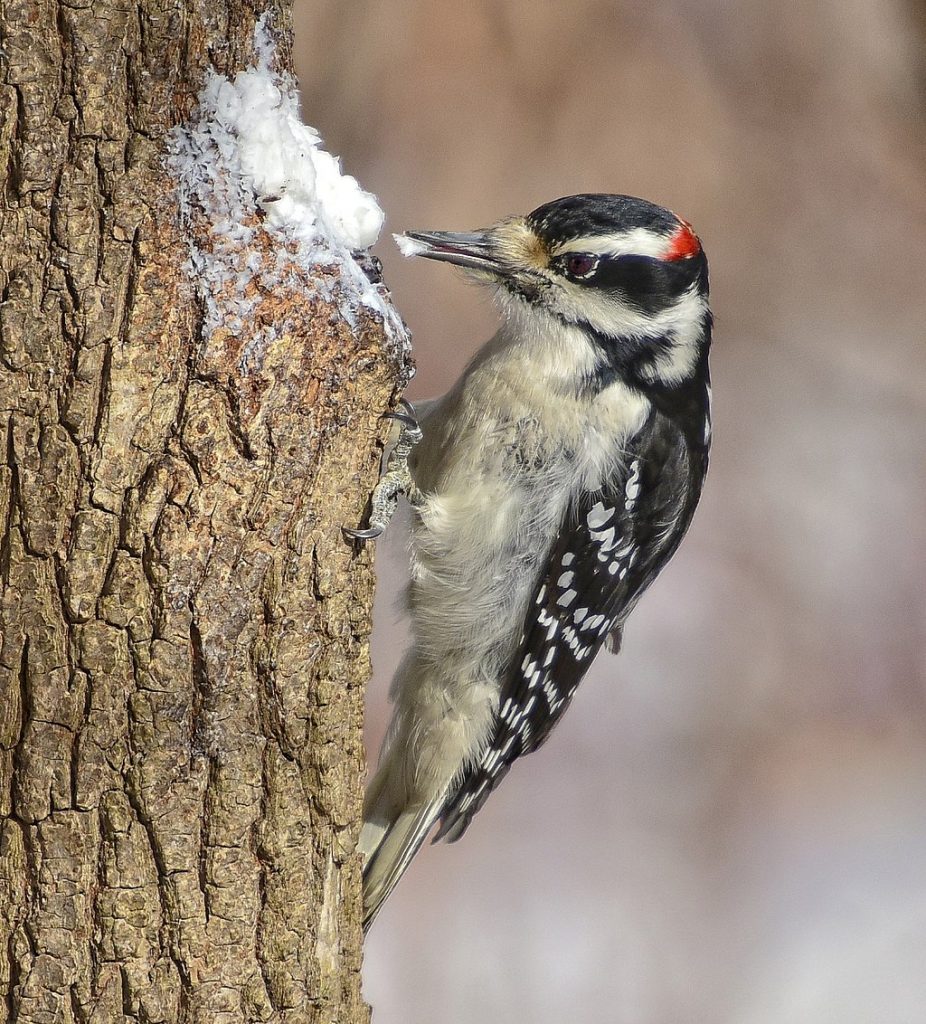
Coloration and Markings: Rather like a larger version of the Downy Woodpecker, they have a white breast and black wings with white stripes marking across from top to bottom. They have short tails and white backs. Facially, they have an orange-red cap at the back of the head (males only), a black stripe across the eye, and a long, sharp black bill.
Size: These birds measure in at 7.1 – 7.9 inches in length with a wingspan of 13 to 16.1 inches, which is about the same size as a Robin.
Habitat: Woodlots, cemeteries, even burned-out forests where they can forage for beetles, these birds are not shy about visiting your garden or feeders if you’ve left them a little something.
Diet: You can tempt this woodpecker into possibly visiting if you prepare your feeder with Peanuts, Black Oil Sunflower, Suet, and/or Peanut Butter & Cornmeal.
Blue Jay – Cyanocitta cristata
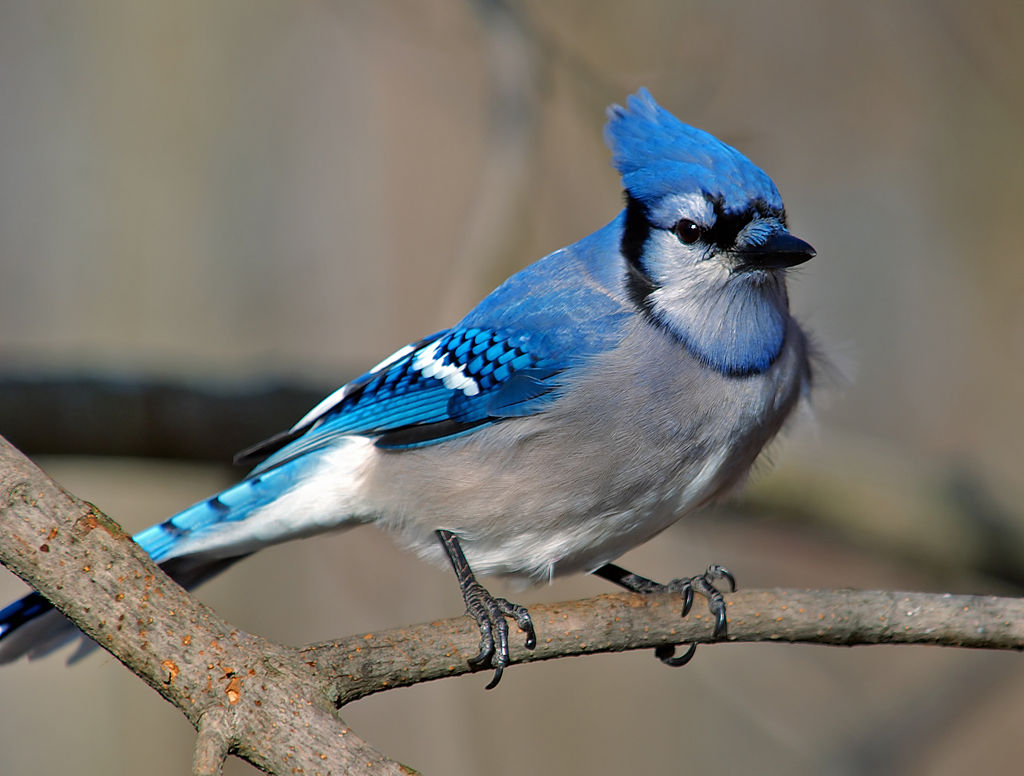
Coloration and Markings: A list of backyard birds wouldn’t be complete without the beloved Blue Jay. With white to gray underbelly, blue and black wings with white stripes and splotches on it’s back and thin black strips on its long tail, it’s a bird that gets your attention right away. Facially, the Blue Jay has a distinctive blue crest as well as a black stripe leading straight down from the end of the crest at the back of the head which curves below the chin around a white face. A black circle is around the eye with a delicate black line tracing back to the crest-curve line and they have a long, thin conical bill.
Size: Measuring 9.8 – 11.8 inches in length, this is a medium to big sized bird. It has a wingspan of about 13.4 to 16.9 inches. It’s about the same size as a Robin.
Habitat: Blue Jays love the city but when they aren’t residential they like the edges of forests and are particularly fond of acorns so they are attracted to Oak trees.
Diet: You can tempt this beautiful bird with a mixture of Peanuts, Black Oil Sunflower, Suet, and Peanut Butter & Cornmeal.
Montana Bird Buffet
If you’ve like to make your own buffet to tempt the local birds then you’ll be interested to know that Birds and Beaseley’s has a seasonal list of bird sightings in the state of Montana where they provide a ‘seed key’ indicating favorites of said birds and it’s good information – we’ve referenced it to help you in luring in these little wonders of nature. Should you wish to make a ‘Montana Bird Buffet’, the seeds and other savories which they’ve listed for our fine, feathered friends are as follows:
- Black Oil Sunflower
- Peanuts
- White Proso Millet
- Suet
- Nyjer Thistle
- Peanut butter
- Cornmeal
Montana Birding Hot spots
Montana is an avian paradise and there are too many hot spots to list. With that in mind, we’ve selected 5 locations at key compass points and we’ll list them in a clockwise fashion. North, East, South, West, and Central. Here you will find 5 hotspots where the Chirparazzi go to photograph the beautiful flying stars of Montana. Use this list is you are visiting Montana or if you simply want to take a little vacation from your own backyard so that you can see some beautiful birds in their natural habitat.
- Northern hotspot – Hebgen Lake
- Eastern hotspot – Manning Lake Wetland Complex
- Southern hotspot – Bridger Sagebrush-shrubsteppe
- Western hotspot – National Bison Range
- Central hotspot – Mussellshell Sage-steppe
Detailed descriptions of each location as well as information regarding visiting and what birds you can see at these locations may be found at the Montana Audobon Society.
Conclusion
With so many species of birds it is impossible in the space that we have for this article to chronicle them all, so if you felt we weren’t obscure enough or did not include your specific area then apologies in advance. For Montana, the Audobon society has some excellent resources that can point you in the right direction for birds specific to you area and we have also listed some references we found helpful in making this article below. What we have provided here is simply a taste of the sumptuous feast that is bird watching in Montana but there is certainly a lot on THIS plate to sample.
Until next time, keep your feeders full and your eyes peeled!
